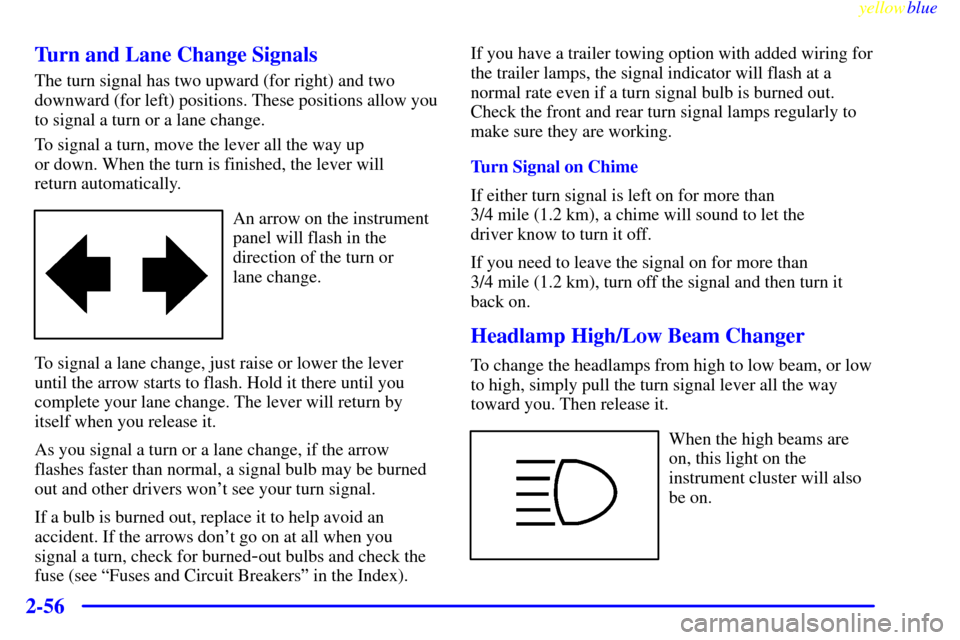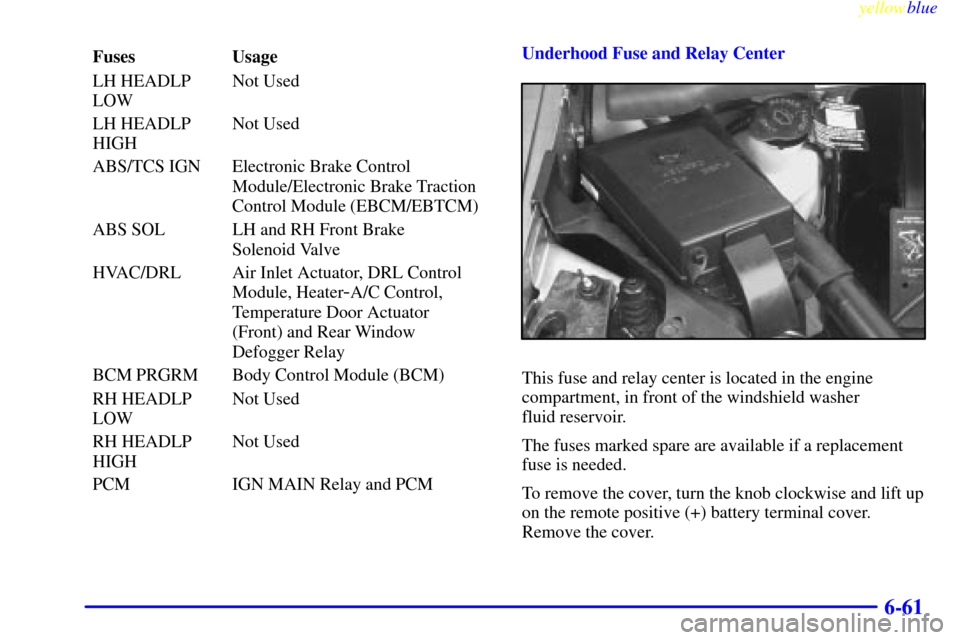1999 CHEVROLET VENTURE fuses
[x] Cancel search: fusesPage 114 of 440

yellowblue
2-14Entering Programming Mode
To program features that are available on your vehicle,
your vehicle must be in the programming mode. Follow
these steps:
1. The Content Theft
-Deterrent system (if equipped)
must be disarmed. See ªContent Theft
-Deterrent
Systemº in this section.
2. Remove the BCM PRGRM fuse from the instrument
panel fuse block, located to the right of the glove
box. (See ªFuses and Circuit Breakersº in the Index.)
3. Close the driver's door.
4. Turn the ignition key towards you to ACCESSORY.
5. Count the number of chimes you hear. You will hear
two to four chimes depending on the features your
vehicle is equipped with. Refer to the chart
shown previously.
You can now program your choices.
To exit the programming mode, follow the steps listed
under ªExiting Programming Modeº later in
this section.
Delayed Illumination and Exit Lighting
With Delayed Illumination, the interior lamps will stay
on for about 25 seconds after all the doors and the
liftgate are closed.
With Exiting Lighting, the interior lamps will come on
and stay on for about 25 seconds whenever you remove
the key from the ignition.
To customize these features to your preference, see
ªProgrammable Modesº following.
Programmable Modes
Your vehicle can be programmed to one of the
following modes.
Mode 1: Both Features Off (The interior lamps will turn on
or off at the same instant that a door is opened or closed.)
Mode 2: Delayed Illumination Only (The interior lamps
will stay on for about 25 seconds after all the doors and
liftgate are closed, or until you lock the doors.)
Mode 3: Exit Lighting Only (The interior lamps will come
on whenever you remove the key from the ignition and stay
on for about 25 seconds, or until you lock the doors.)
Mode 4: Both Features On (This combines Modes 2 and 3.)
Vehicles are delivered programmed in Mode 4.
Page 136 of 440

yellowblue
2-36
This device complies with Part 15 of the FCC Rules.
Operation is subject to the following two conditions:
(1) this device may not cause harmful interference,
and (2) this device must accept any interference
received, including interference that may cause
undesired operation.
This device complies with RSS
-210 of Industry Canada.
Operation is subject to the following two conditions:
(1) this device may not cause interference, and (2) this
device must accept any interference received, including
interference that may cause undesired operation of
the device.
Changes or modifications to this system by other than an
authorized service facility could void authorization to
use this equipment.
PASS
-Key III uses a radio frequency transponder in the
key that matches a decoder in your vehicle.
When the PASS
-Key III system senses that someone is
using the wrong key, it shuts down the vehicle's starter
and fuel systems. The starter will not work and fuel will
stop being delivered to the engine. Anyone using a
trial
-and-error method to start the vehicle will be
discouraged because of the high number of electrical
key codes.When trying to start the vehicle if the engine does not
start and the PASS KEY light comes on, the key may
have a damaged transponder. Turn the ignition off and
try again.
If the engine still does not start, and the key appears to
be undamaged, try another ignition key. At this time,
you may also want to check the fuse (see ªFuses and
Circuit Breakersº in the Index). If the engine still does
not start with the other key, your vehicle needs service.
If your vehicle does start, the first key may be faulty.
See your dealer or a locksmith who can service the
PASS
-Key III to have a new key made.
It is possible for the PASS
-Key III decoder to learn the
transponder value of a new or replacement key. Up to
10 additional keys may be programmed for the vehicle.
This procedure is for learning additional keys only. If all
the currently programmed keys are lost or do not
operate, you must see your dealer or a locksmith who
can service PASS
-Key III to have keys made and
programmed to the system.
See your dealer or a locksmith who can service
PASS
-Key III to get a new key blank that is a cut
exactly as the ignition key that operates the system.
Page 156 of 440

yellowblue
2-56Turn and Lane Change Signals
The turn signal has two upward (for right) and two
downward (for left) positions. These positions allow you
to signal a turn or a lane change.
To signal a turn, move the lever all the way up
or down. When the turn is finished, the lever will
return automatically.
An arrow on the instrument
panel will flash in the
direction of the turn or
lane change.
To signal a lane change, just raise or lower the lever
until the arrow starts to flash. Hold it there until you
complete your lane change. The lever will return by
itself when you release it.
As you signal a turn or a lane change, if the arrow
flashes faster than normal, a signal bulb may be burned
out and other drivers won't see your turn signal.
If a bulb is burned out, replace it to help avoid an
accident. If the arrows don't go on at all when you
signal a turn, check for burned
-out bulbs and check the
fuse (see ªFuses and Circuit Breakersº in the Index).If you have a trailer towing option with added wiring for
the trailer lamps, the signal indicator will flash at a
normal rate even if a turn signal bulb is burned out.
Check the front and rear turn signal lamps regularly to
make sure they are working.
Turn Signal on Chime
If either turn signal is left on for more than
3/4 mile (1.2 km), a chime will sound to let the
driver know to turn it off.
If you need to leave the signal on for more than
3/4 mile (1.2 km), turn off the signal and then turn it
back on.
Headlamp High/Low Beam Changer
To change the headlamps from high to low beam, or low
to high, simply pull the turn signal lever all the way
toward you. Then release it.
When the high beams are
on, this light on the
instrument cluster will also
be on.
Page 182 of 440

yellowblue
2-82
To use your air inflator system, the engine must be
running or the ignition key in ACCESSORY. Attach the
appropriate nozzle adapter, if required, to the end of the
hose that has the pressure gage. Then attach that end of
the hose to the object you wish to inflate. Remove the
protective cap covering the outlet. Attach the other end
of the hose to the outlet. Press the ON switch.If the air inflator system does not turn on, the fuse may
be blown or installed incorrectly. See ªFuses and Circuit
Breakersº in the Index or see your dealer for service.
Your air inflator will automatically shut off after about
10 minutes. To reset, press the ON switch again.
Don't run your air inflator for longer than 30 minutes at
one time. If you do, you may damage the system. After
30 minutes, wait at least 10 minutes before restarting the
air inflator.
To turn off the inflator, press OFF and detach the hose,
first from the inflated object, then from the outlet.
Replace the protective cap. Place the inflator kit tools in
the pouch, and store in the glove box.
To replace the cover, line up the tabs at the back of the
cover and put it in place. Push down the tab to secure
the cover.
Page 368 of 440

yellowblue
6-58 Fuses and Circuit Breakers
The wiring circuits in your vehicle are protected from
short circuits by a combination of fuses, circuit breakers
and fusible thermal links.
Look at the silver
-colored band inside the fuse. If the
band is broken or melted, replace the fuse. Be sure you
replace a bad fuse with a new one of the identical size
and rating.
If you ever have a problem on the road and don't have a
spare fuse, you can borrow one that has the same
amperage or use one of the spare fuses in the underhood
fuse and relay center. Just pick some feature of your
vehicle that you can get along without
-- like the radio
or cigarette lighter
-- and use its fuse, if it is the right
amperage. Replace it as soon as you can.
There are two fuse blocks in your vehicle: the
instrument panel fuse block and the underhood fuse and
relay center.Instrument Panel Fuse Block
The instrument panel fuse
block is located to the right
of the glove box. Pull the
door open to access the
instrument panel fuse block.
Pull the door open to access the instrument panel
fuse block.
Page 369 of 440

yellowblue
6-59
Circuit
BreakersUsage
HEADLAMP DRL Control Module, Headlamp and
Instrument Panel Dimmer Switch
PWR WDO Front Power Windows
PWR SEAT/PSD 6
-Way Power Seat(s) and Rear
Side Door Actuator Motor
FRT HVAC/HI
BLWRBlower Motor Hi Speed
Relay ModuleFuses Usage
SWC
BACKLIGHTSteering Wheel Radio Control
Switches (Illumination)
ELEC PRNDL Instrument Cluster to PRNDL
Indicators
PWR MIRROR Power Remote Control
Mirror Switch
CRUISE Cruise Control Module, Switch
and Release Switch
PWR QTR
VENTInterior Lamps and Multifunction
Switch (Power Vent Switch)
FRT
WPR/WSHRWindshield Wiper/Washer Motor
and Switch
PASS KEY PASS
-Key System
PWR LOCK Body Control Module (BCM)
HTD MIRROR Heated Mirrors
RH T/LP Not Used
RR FOG LP Not Used
CIGAR/DLC Cigarette Lighter and Data Link
Connector (DLC)
T/SIG Turn Signal Switch
RR HVAC Rear Blower Motor, Rear
Heater
-A/C Control, Temperature
Door Actuator (Rear)
Page 370 of 440

yellowblue
6-60
Fuses Usage
SWC ACCY Steering Wheel Radio
Control Switches
HAZARD Turn Signal Switch
RR PWR SCKT Rear Electric Accessory
Plug Housing
DRL Daytime Running Lamps (DRL)
Control Module
LH T/LP Not Used
RR DEFOG Rear Window Defogger Relay,
Heated Mirrors
FRT PWR SCKT Front Electric Accessory Plug
Housing
SIR Inflatable Restraint
Control Module
FRT HVAC
LOW/MED
BLWRHeater
-A/C Control
MALL/RADIO/
DICBCM, Driver Information Display,
Rear Seat Audio, ELC Sensor
and Relay
STOP LAMP Stoplamp SwitchFuses Usage
ABS MOD
BATTElectronic Brake Control
Module/Electronic Brake Traction
Control Module (EBCM/EBTCM)
CAN VENT
SOLEvaporative Emissions (EVAP)
Canister Vent Solonoid Valve
ELC Electronic Level Control (ELC)
Air Compressor and ELC Relay,
Trailer Harness
CTSY LAMP BCM
IGN 1 BCM, Electronic Brake Control
Indicator Lamp Driver Module,
Instrument Panel Cluster, Rear
Side Door Actuator Control
Module, Rear Window
Wiper/Washer and Multifunction
Switch (Fog Lamp
Switch/Traction Control Switch)
and Stoplamp/Torque Converter
Clutch (TCC) Switch
RR WPR WSHR Rear Window Wiper Motor, Rear
Window Wiper/Washer and
Multifunction Switch (Rear
Window Wiper/Washer Switch)
Page 371 of 440

yellowblue
6-61
Fuses Usage
LH HEADLP
LOWNot Used
LH HEADLP
HIGHNot Used
ABS/TCS IGN Electronic Brake Control
Module/Electronic Brake Traction
Control Module (EBCM/EBTCM)
ABS SOL LH and RH Front Brake
Solenoid Valve
HVAC/DRL Air Inlet Actuator, DRL Control
Module, Heater
-A/C Control,
Temperature Door Actuator
(Front) and Rear Window
Defogger Relay
BCM PRGRM Body Control Module (BCM)
RH HEADLP
LOWNot Used
RH HEADLP
HIGHNot Used
PCM IGN MAIN Relay and PCMUnderhood Fuse and Relay Center
This fuse and relay center is located in the engine
compartment, in front of the windshield washer
fluid reservoir.
The fuses marked spare are available if a replacement
fuse is needed.
To remove the cover, turn the knob clockwise and lift up
on the remote positive (+) battery terminal cover.
Remove the cover.